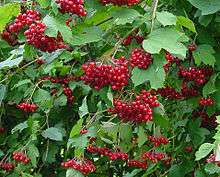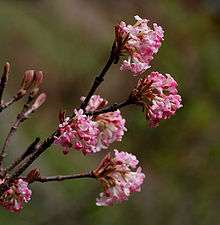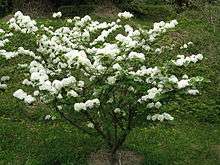Viburnum
Viburnum is a genus of about 150–175 species of flowering plants in the moschatel family Adoxaceae. Its current classification is based on molecular phylogeny.[2] It was previously included in the honeysuckle family Caprifoliaceae.[1]
| Viburnum | |
|---|---|
 | |
| Viburnum opulus fruit | |
| Scientific classification | |
| Kingdom: | Plantae |
| Clade: | Tracheophytes |
| Clade: | Angiosperms |
| Clade: | Eudicots |
| Clade: | Asterids |
| Order: | Dipsacales |
| Family: | Adoxaceae |
| Genus: | Viburnum L.[1] |
| Species | |
|
See text | |
The member species are evergreen or deciduous shrubs or (in a few cases) small trees native throughout the temperate Northern Hemisphere, with a few species extending into tropical montane regions in South America and southeast Asia. In Africa, the genus is confined to the Atlas Mountains.
Name
The generic name originated in Latin, where it referred to V. lantana.[3]
Description
The leaves are opposite, simple, and entire, toothed or lobed; cool temperate species are deciduous, while most of the warm temperate species are evergreen. Some species are densely hairy on the shoots and leaves, with star-shaped hairs.
The flowers are produced in corymbs 5–15 cm across, each flower white to cream or pink, small, 3–5 mm across, with five petals, strongly fragrant in some species. The gynoecium has three connate carpels with the nectary on top of the gynoecium. Some species also have a fringe of large, showy sterile flowers around the perimeter of the corymb to act as a pollinator target.
The fruit is a spherical, oval, or somewhat flattened drupe, red to purple, blue, or black, and containing a single seed; some are edible for humans, but many others are mildly poisonous. The leaves are eaten by the larvae of many Lepidoptera species.
Birds eat the berries of Viburnum obovatum (also called Walter Viburnum after Thomas Walter).[4]
Species
Around 165 species are described. A 2014 phylogenetic study[5] proposed the following phylogenetic scheme and sections:
Viburnum Phylogenetic Tree | ||||||||||||||||||||||||||||||||||||||||||||||||||||||||||||||||||||||||||||||||||||||||||||||||||||||||||||||||||||||||||||||
|---|---|---|---|---|---|---|---|---|---|---|---|---|---|---|---|---|---|---|---|---|---|---|---|---|---|---|---|---|---|---|---|---|---|---|---|---|---|---|---|---|---|---|---|---|---|---|---|---|---|---|---|---|---|---|---|---|---|---|---|---|---|---|---|---|---|---|---|---|---|---|---|---|---|---|---|---|---|---|---|---|---|---|---|---|---|---|---|---|---|---|---|---|---|---|---|---|---|---|---|---|---|---|---|---|---|---|---|---|---|---|---|---|---|---|---|---|---|---|---|---|---|---|---|---|---|---|
|
- V. clemensiae Kern
Lentago – Eastern North America except for V. elatum in Mexico[6]
- V. cassinoides L. – Witherod viburnum, wild raisin, Appalachian tea
- V. elatum Benth
- V. lentago L. – nannyberry
- V. nudum L. – possumhaw
- V. obovatum Walter – Small-leaf Virbunum
- V. prunifolium L. – blackhaw
- V. rufidulum Raf. – rusty blackhaw
Punctata
- Viburnum lepidotulum Merr. & Chun
- Viburnum punctatum Buch.-Ham. Ex D. Don
Euviburnum
- V. bitchiuense Makino
- V. buddleifolium
- V. burejaeticum Regel et Herder
- V. carlesii Hemsl. Ex Forb. & Hemsl. – Korean spice viburnum
- V. cotinifolium D. Don
- V. lantana L. – wayfaring tree, hoarwithy
- V. macrocephalum Fortune – Chinese viburnum (琼花)
- V. mongolicum (Pall.)Rehder
- V. rhytidophyllum Hemsl. Ex Forb. & Hemsl. – wrinkled viburnum
- V. schensianum Maxim.
- V. utile Hemsl. – service viburnum
- V. veitchii C.H. Wright – service viburnum
Pseudotinus – Asia, except V. lantanoides in Eastern North America[6]
- V. furcatum Blume ex Hook.f. & Thomson – forked viburnum, scarlet leaved viburnum
- V. lantanoides Michx. – hobble-bush, American wayfaring tree
- V. nervosum D. Don
- V. sympodiale Graebn.
Solenotinus – Asia, extending west to India and south to Indonesia[6]
- V. awabuki Hort.Berol. Ex K. Koch
- V. brachybotryum Hemsl.
- V. chingii P.S. Hsu
- V. corymbiflorum P.S. Hsu & S.C. Hsu
- V. erubescens Wall
- V. farreri Stearn – Farrer's viburnum
- V. foetens
- V. grandiflorum Wall. Ex DC – Himalayan viburnum
- V. henryi Hemsl.
- V. odoratissimum Ker-Gawl. – sweet viburnum
- V. oliganthum Batalin
- V. sieboldii Miq. – Siebold's viburnum
- V. subalpinum Hand.-Mazz.
- V. suspensum Lindl. – Sandankwa viburnum
- V. taitoense Hayata
Lutescentia (excluding Tomentosa)
- V. amplifolium
- V. colebrookeanum Wall. Ex DC
- V. garrettii
- V. junghunii
- V. laterale
- V. lutescens Blume
- V. pyramidatum
Tomentosa – China, Japan[6]
- V. plicatum Thunberg – Japanese snowball
- V. hanceanum
Amplicrenotinus (excluding Crenotinus)
- V. amplificatum J. Kern
Urceolata
- V. taiwanianum Hayata
- V. urceolatum Siebold & Zucc.
Tinus – Asia, except V. tinus in Europe[6]
- V. atrocyaneum C.B. Clarke
- V. calvum Rehder
- V. cinnamomifolium Rehder – cinnamon-leaved viburnum
- V. davidii Franchet – David viburnum
- V. propinquum Hemsl.
- V. rigidum Vent.
- V. tinus M.J. – Laurustinus
- V. triplinerve
Corisuccotinus (excluding Succotinus and Coriaceae)
- V. acerifolium L. – maple-leaf viburnum
- V. kansuense Batalin
- V. orientale Pall.
Succotinus
- V. adenophorum W.W. Sm.
- V. annamensis Fukouoka
- V. betulifolium Batalin
- V. brachyandrum Nakai
- V. corylifolium Hook.f. & Thomson
- V. dilatatum Thunberg – linden viburnum
- V. erosum Thunberg
- V. flavescens W.W. Sm.
- V. foetidum (Graebn.) Rehder
- V. formosanum Hayata
- V. hupehense Rehder
- V. ichangense Rehder
- V. integrifolium Hayata
- V. japonicum Spreng
- V. lobophyllum
- V. luzonicum Rolfe
- V. melanocarpum Hsu in Chen et al.
- V. mullaha Buch.-Ham. Ex D.Don
- V. parvifolium Hayata
- V. sempervirens K. Koch
- V. setigerum M.J. Donoghue – tea viburnum
- V. tashiroi Nakai
- V. wrightii Miquel – Wright's viburnum
Coriaceae
- V. coriaceum Blume
- V. cylindricum Buch.-Ham. ex D. Don
- V. hebanthum Wight & Arn.
Sambucina
- V. beccarii Gamble
- V. hispidulum J. Kern
- V. inopinatum Craib.
- V. sambucinum Reinew. Ex Blume
- V. vernicosum Gibbs
- V. ternatum Rehder
Opulus – Circumboreal[6]
- V. edule Raf. – squashberry, mooseberry, pembina, pimbina, lowbush cranberry, moosomin (Cree language)
- V. koreanum – Korean viburnum
- V. opulus L. – Guelder-rose
- V. sargentii Koehne – Tianmu viburnum (天目琼花)
- V. trilobum Marshall – high bush viburnum
Mollotinus
- V. australe C.V. Morton – Mexican arrowwood
- V. bracteatum Rehder – bracted arrowwood, limerock arrowwood
- V. ellipticum Hook. – common viburnum, oval-leaved viburnum
- V. molle Michx. – softleaf arrowwood
- V. rafinesquianum Schult. – downy arrowwood
Dentata – Mexico, Caribbean, and Central and South America[6]
- V. dentatum L. – arrowwood viburnum
- V. recognitum Fernald – smooth arrowwood
Oreinotinus – Mexico, Caribbean, and Central and South America[6]
- V. acutifolium Benth.
- V. caudatum Greenm.
- V. costaricanum (Oerst.) Hemsl.
- V. discolor Benth.
- V. disjunctum C.V. Morton
- V. divaricatum
- V. jamesonii (Oerst.)Killip & A.C. Sm.
- V. jucundum C.V. Morton
- V. lautum C.V. Morton
- V. loeseneri Graebn.
- V. stellato-tomentosum (Oerst.) Hemsl.
- V. stenocalyx Hemsl.
- V. sulcatum (Oerst.) Hemsl.
- V. toronis Killip & A.C. Sm.
- V. triphyllum Benth. – chuchua, chuque
Undetermined
- V. arboreum
- V. betulifolium Batalin
- V. glomeratum
- V. hondurense
- V. maculatum
- V. molinae
- V. mortonianum
- V. phlebotrichum
- V. subpubescens
- V. treleasei
- V. tridentatum
- V. venosum (or V. dentata var venosum)
Formerly placed here
- Hydrangea arborescens L. (as V. alnifolium Marshall, or V. americanum Mill.)
- Hydrangea macrophylla (Thunb.) Ser. (as V. macrophyllum Thunb.)[7]
Cultivation and uses


Many species of viburnum have become popular as garden or landscape plants because of their showy flowers and berries, fragrance, and good autumn colour of some forms. Some popular species, hybrids, and cultivars include:[8]
- The hybrid Viburnum × bodnantense (V. farreri × V. grandiflorum) is particularly popular for its strongly scented pink flowers on the leafless deciduous shoots in mid- to late winter.
- Viburnum × burkwoodii (V. carlesii × V. utile)
- Viburnum × carlcephalum (V. carlesii × V. macrocephalum)
- Viburnum carlesii has round white flowerheads, strong fragrance, dense structure, and reddish leaves in autumn.
- Viburnum davidii is an evergreen species from China with blue fruit.
- Viburnum dentatum has flat-topped flowers, bluish fruit, and reddish leaves in autumn. It is somewhat salt-tolerant. The cultivar 'Blue Muffin' is more compact than the species and has fruit that are a deeper blue than the species.
- Viburnum dilatatum has flat-topped flowers, reddish leaves in autumn, and bright red fruit that persist into winter.
- Viburnum × jackii – Jack's viburnum
- Viburnum × juddii (V. bitchiuense × V. carlesii)
- Viburnum plicatum has white flowers, textured leaves, reddish-black fruit, and can grow quite large under ideal conditions. The species can tolerate shade, but not drought.
- Viburnum × pragense (V. rhytidophyllum × V. utile)
- Viburnum × rhytidophylloides (V. lantana × V. rhytidophyllum)
- Viburnum rhytidophyllum is a popular evergreen species, grown mainly for its foliage effect of large, dark green leathery leaves with strongly wrinkled surface. This is the parent species of two popular hybrid cultivars known as 'Alleghany' and 'Pragense'. 'Alleghany' was selected from a hybrid between V. rhytidophyllum and V. lantana 'Mohican' (in 1958, at the US National Arboretum).
- Viburnum setigerum has upright, coarse structure and orange to reddish-orange fruit.
- Viburnum sieboldii has coarse, open structure, flat-topped flowers, reddish-black fruit, and can grow as a small tree.
- Viburnum tinus is a widely grown garden and landscape shrub.
Other uses
In prehistory, the long, straight shoots of some viburnums were used for arrow-shafts, as those found with Ötzi the Iceman.
The fruit of some species (e.g. V. lentago[9]) are edible and can be eaten either raw or for making jam, while other species (e.g. V. opulus[10]) are mildly toxic and can cause vomiting if eaten in quantity.
The bark of some species is used in herbal medicine, as an antispasmodic and to treat asthma.[10]
Cultural references
In Ukraine and Russia Viburnum opulus is an important element of their traditional folk cultures. In Ukraine, Viburnum opulus (kalyna) is seen as a national symbol, an emblem for both the Koliada festivities and the concept of young girl's love and tenderness. It is the key element of the Ukrainian traditional wreath.[11][12] In Russia the Viburnum fruit is called kalina (калина) and is considered a national symbol. Kalina derived in Russian language from kalit' or raskalyat', which means "to make red-hot". The red fiery color of the berries represents beauty in Russian culture and together with sweet raspberries it symbolise the passionate love of a beautiful maiden, since berries were always an erotic symbol in Russia.[13] The name of the Russian song Kalinka is a diminutive of Kalina. Viburnum opulus is also an important symbol of Russian national ornamental wood painting handicraft style called Khokhloma.
References
| Wikimedia Commons has media related to Viburnum. |
| Wikispecies has information related to Viburnum |
- "Genus: Viburnum L." Germplasm Resources Information Network. United States Department of Agriculture. 2006-11-03. Archived from the original on 2011-06-05. Retrieved 2010-11-04.
- Winkworth, R. C.; Donoghue, M. J. (2005). "Viburnum phylogeny based on combined molecular data: implications for taxonomy and biogeography". American Journal of Botany. 92 (4): 653–66. doi:10.3732/ajb.92.4.653. PMID 21652443.
- Quattrocchi, Umberto (2000). CRC World Dictionary of Plant Names: Common Names, Scientific Names, Eponyms, Synonyms, and Etymology. IV R-Z. Taylor & Francis US. p. 2793. ISBN 978-0-8493-2678-3.
- Little, Elbert L. (1980). The Audubon Society Field Guide to North American Trees: Eastern Region. New York: Knopf. p. 674. ISBN 0-394-50760-6.
- Clement; Arakaki; Sweeny; Edwards; Donoghue (1 June 2014). "A chloroplast tree for Viburnum (Adoxaceae) and its implications for phylogenetic classification and character evolution". American Journal of Botany. 101 (6): 1029–1049. doi:10.3732/ajb.1400015. PMID 24928633.
- Donoghue; Baldwin; Li; Winkworth (1 January 2004). "Viburnum Phylogeny Based on Chloroplast trnK Intron and Nuclear Ribosomal ITS DNA Sequences". Systematic Botany. 29 (1): 188–198. doi:10.1600/036364404772974095.
- "GRIN Species Records of Viburnum". Germplasm Resources Information Network. United States Department of Agriculture. Retrieved 2010-11-04.
- Huxley, A., ed. (1992). New RHS Dictionary of Gardening. Macmillan ISBN 0-333-47494-5.
- Plants for a future: Viburnum lentago
- Plants for a future: Viburnum opulus
- Верба и калина - символы Украины. Verba and kalyna are Ukraine’s national symbols. - kievcolours.com. - "Калина… символизировала праздник Коляды, Рождества мира. Надругательство над ней покрывало человека позором, также как и убийство аиста." – Kalyna symbolized the Kolyada festivities. Somebody who’d kill a stork or abuse kalyna was considered forever disgraced.
- The herbs. Myths and Legends. - myphs.jimdo.com. – «Без верби і калини нема України» // «Without verba [pussy-willow] & kalyna [viburnum], there is no Ukraine.»
- 1946-, Prokhorov, Vadim (2002). Russian folk songs : musical genres and history. Lanham, Md.: Scarecrow Press. p. 149. ISBN 0810841274. OCLC 47208585.CS1 maint: numeric names: authors list (link)